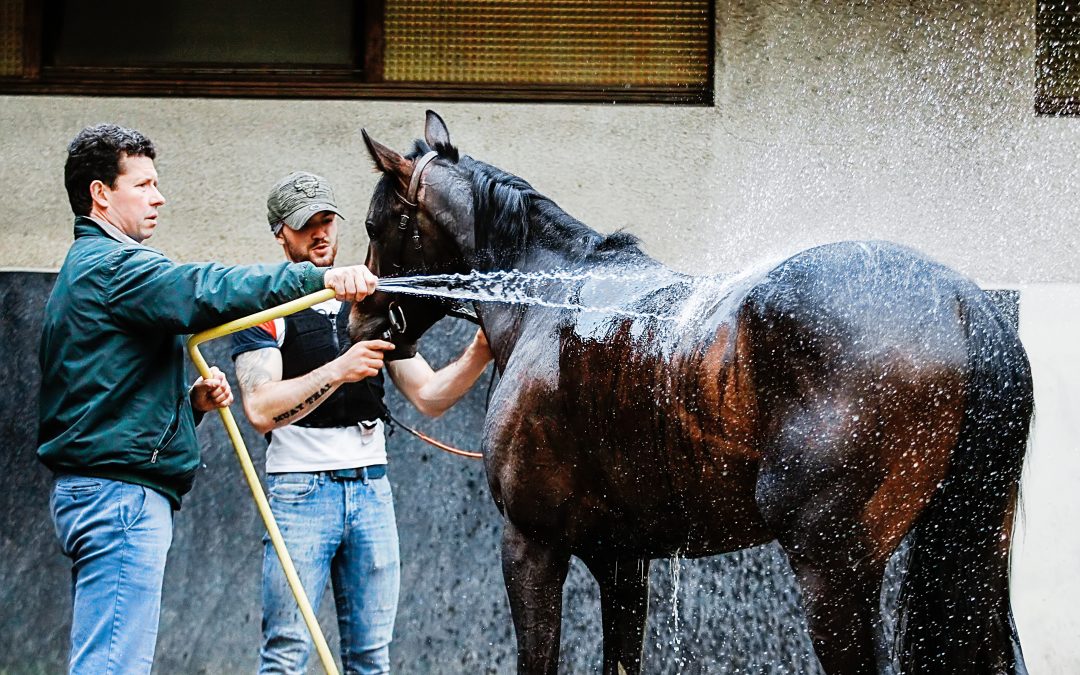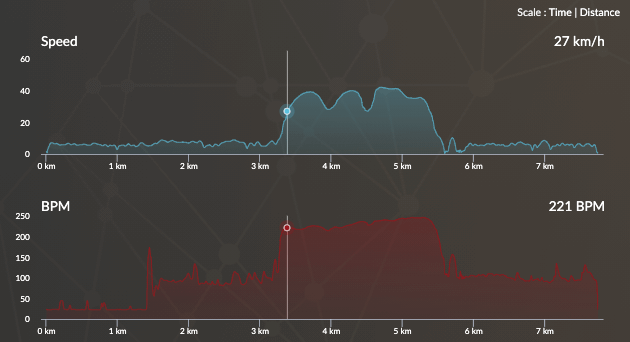How to limit the risk of injury in horses?
#RaceAndCare
Animal welfare issues are at the center of current political debates. The racehorse’s welfare is a key element of institutions’ policy in the racing industry. Tracking tools are more than ever necessary to ensure an efficient and optimal medical follow-up. Just as human athletes, racehorses follow an intense training program, pushing their body limits. If it is not sufficiently managed, this preparation can lead to the development of pathologies. It is therefore necessary to find a balance between overtraining and undertraining in order to combine performance and equine welfare.
The new technologies available on the market provide a new tool for prevention. Analysing the heart rate, assessing recovery capacity or the symmetry of gait are preventive actions to detect the warning signs of serious pathologies. Establishing a partnership with the stable veterinarian therefore allows to monitor the health of the horses on a daily basis, without requiring his presence every day during training. The Arioneo team has studied the different pathologies encountered in racehorses during training and how to detect them.
1. Prevent overtraining
Overtraining is a chronic state of fatigue characterized by a decrease in performance. It occurs when the balance between training induced fatigue and the recovery capacity of training is negatively disturbed. It is essential to include recovery phases in a racehorse’s program, especially for young horses just starting out. These recovery periods help to rebalance the body and maintain the health of horses.
Symptoms
Overtraining syndrome can be detected by monitoring the appearance of several symptoms. Weight loss without loss of appetite is the first symptom to watch for. It usually occurs three weeks before the other symptoms and can be difficult to detect. A significant drop in performance may then be observed. The horse is no longer able to hold his effort as long as before. Finally, the last symptom can be the behaviour modification. Although it is difficult to quantify and qualify it, rides may notice strong irritability, reluctance to work or bites on the harness. These modifications are very diverse and remain specific to each horse.
Prevention
Preventive work can be carried out to avoid the development of overtraining. Two parameters should be monitored (in addition to weight): heart rate and recovery allow to detect whether the horse is holding his effort normally or whether, on the contrary, his behaviour is abnormal.
Checking the recovery indicators to ensure that they do not deteriorate from one training session to the next is an example of an action to be implemented in order to monitor the horse’s fitness level and prevent over and under training. If recovery is poor, abnormally high heart rate levels (compared to previous ones) will be visible. It would then be appropriate to involve the vet so that he can analyse his electrocardiogram.
2. Prevent fatigue fractures
A fatigue fracture is defined as an unfinished fracture, generated by a repetition of mechanical stress on the horse’s bone. The load applied to the bone is less than the load required to produce a complete fracture. However, this load is sufficient to create microcracks in the bone structure. Young racehorses are often prone to fatigue fractures as increased intensity or frequency of training can cause the bone to become fragile. Fatigue fractures can occur in different places.
Symptoms
The main symptom to monitor is the appearance of lameness following a drop in performance. It can disappear with rest and reappear after intensive training. Some horses do not show any signs of pain until they reach a fracture. Other symptoms may alert and allow the problem to be treated beforehand:
– Pain in the lower part of the forefoot
– Hot bump on the barrel
– Horse that prioritises one leg to move around
– Limping
– Decrease in usual performance
Prevention
The regular monitoring of a horse allows to gather an interesting data history and to obtain reference data for each horse: his usual heart rate, his recovery levels, his locomotor profile. An abnormal increase in heart rate may, for example, indicate pain or an unusually poor recovery capacity. In addition, the analysis of locomotion data (stride length and stride frequency) is a starting point in the detection of fatigue fractures. For example, the observation of an irregularity in the data can be a warning sign of limping.
3. Detecting respiratory issues
The horse respiratory system is constantly subjected to high environmental pressures (e.g. dust and humidity). These can lead to inflammation of the respiratory system. There are many causes of respiratory diseases: infectious, allergic, irritating, anatomical, pulmonary bleeding, etc.
Symptoms
A horse suffering from respiratory disease may present one or more of the symptoms are the following: cough, nasal discharge, increased respiratory effort at rest, abnormal breathing during activity, slow recovery after effort, decrease in performance, blood in the nostrils after exercise
Prevention
It is possible to prevent the development of this type of respiratory problem or to detect it beforehand by monitoring the heart rate during exercise. Here is an example of training monitored by EQUIMETRE.
We can see that this horse reaches his maximum heart rate as soon as he starts galloping. This represents an abnormal situation, all the more so as he is not launched at maximum speed. When analysing this training, the trainer should ask to consult his veterinarian in order to investigate the problem.
4. Detecting arrhythmias
Cardiac arrhythmias are disturbances in the rhythm of the horse’s heart. They can be abnormal or normal. They are quite common in very athletic horses and can become problematic when they compromise the blood circulation and disrupt the supply of oxygen (through the blood) to the muscles. These cardiac conditions are particularly dangerous as they can disrupt the distribution of blood in the vascular network. If the supply of oxygen to the brain is suddenly reduced, the horse may, for example, faint. If the supply of oxygen to the muscles is disrupted when the horse is in full exercise, it will slow down in his work and potentially be underperforming.
Symptoms
Poor recovery during low intensity exercise is often considered a warning sign of abnormal arrhythmia.
Detection
There are several ways to detect arrhythmias. For example, one can take the horse’s pulse or use a stethoscope to check the heart, but this requires the horse to be at rest. It is also possible to record an electrocardiogram (ECG) and thus analyse the electrical activity of the heart during exercise. This ECG monitoring during activity is particularly interesting for racehorses.

This horse suffers from atrial fibrillation

This horse does not present any visible pathology on the ECG.
5. Preventing sudden death in racehorses
Sudden death in horses is defined as the natural death of an individual whose delay between the appearance of the first alarming symptoms and death is less than 48 hours. The particularity of such a death is that the horse appears healthy at first sight. This phenomenon affects 13% of racehorses that die on a racecourse in Australia. Good monitoring of horses can help to avoid such disasters thanks to the data collected. Indeed, the monitoring of cardiac parameters is a tool in the prevention of the development of serious cardiac pathologies. Poor recovery can then be analysed by the veterinarian remotely thanks to the data collected.
The causes of sudden death
There are three main families of causes of sudden death: cardio-respiratory failure, bleeding shocks and central nervous system damage. Preventing the symptoms and preserving the health of the athletic horse. Last July, the Arioneo team had the chance to interview Emmanuelle van Erck on the subject and here is her advice on risk prevention and control.
A horse with a cardiac arrhythmia does not generally develop it overnight without warning signs. So, if we can equip this horse with an Equimetre during training, we will be able to detect these signs. Rhythm disturbances can be highlighted on his ECG, if necessary. These may result in the death of the horse during the race. Fortunately, they can be detected by the warning signals visible during intense training recorded with the sensor. This helps to avoid enrolling a horse in a race who does not have the ability to hold the race and may collapse at the end of the race. Ideally, trainers should be aware of the importance of detecting pathologies as early as possible in order to avoid making a potentially endangered horse race.
In practical everyday life, how can you limit the risk of injury in racehorses?
Veterinary telemedicine is a form of remote practice based on the use of new technologies. The use of telemedicine is beneficial for the monitoring of a stable of racehorses. Indeed, it is possible to use a sensor such as EQUIMETRE to carry out preventive work. The training data collected can be remotely accessible for the veterinarian. The latter is then able to monitor the horses in training from his practice and to investigate specific suspect cases in greater depth. He can therefore prioritise his consultations. This telemedicine work also enables remote detection of pathologies thanks to the consultation of effort ECGs recorded remotely by the sensor.
Carrying out prevention work with the EQUIMETRE sensor
As a general rule, the parameters to be monitored in priority are: heart rate, recovery and locomotor data.
Heart rate – A parameter measuring the fitness of the horse, it is also an indicator of pain detection. Acquiring a history of data to compare allows an abnormally high heart rate to be detected in order to detect a possible cardiac problem or pain that could herald a fracture.
Recovery – By analysing the evolution of the heart rate, you can see how the horse has worked and recovered. The horse’s level of recovery is quantified and can therefore be compared with other training sessions. Poor recovery can be a warning of possible sub-clinical pathologies.
Locomotor parameters – It is possible to detect lameness by analysing the symmetry indicator: a horse in pain will tend to modify its stride and locomotion in order to relieve the painful limb. By doing so, the horse is no longer symmetrical. An increase in stride frequency can also be synonymous with pain. Indeed, if a limb is painful, the horse will not put in all the power necessary to maintain a good stride length, and will therefore have to stride more frequently to maintain the required speed.
Key words: racehorse injuries, animal welfare, racehorse undertraining, overtraining, horse heart rate, horse gait symmetry, prevent overtraining, prevent fatigue fractures, locomotor profile, detecting respiratory issues, cardiac arrythmias, racehorse poor recovery, racehorse ECG, sudden death, cardiac parameters monitoring, veterinary telemedecine




